Defining and Enforcing Corporate Culture: A Detailed Analysis
VerifiedAdded on 2023/06/12
|5
|1317
|279
Essay
AI Summary
This essay provides a comprehensive overview of corporate culture, defining it as the shared beliefs and behaviors that shape interactions within an organization, particularly in the banking sector. It emphasizes that corporate culture evolves organically and encompasses values, norms, language, and assumptions. The essay details various factors influencing the enforcement of corporate culture, including the founders' values, industry demands, and operational goals. Key steps for effective enforcement include defining the company's legacy, codifying social decisions, aligning hiring practices with stated values, improving onboarding processes, and fostering engagement. It highlights the importance of leadership in prioritizing cultural changes and making decisions that support employees and vendors. The essay concludes by stressing the need for continuous improvement and adaptation in hiring practices and employee onboarding to ensure that corporate culture is effectively maintained and reinforced across all levels of the organization.
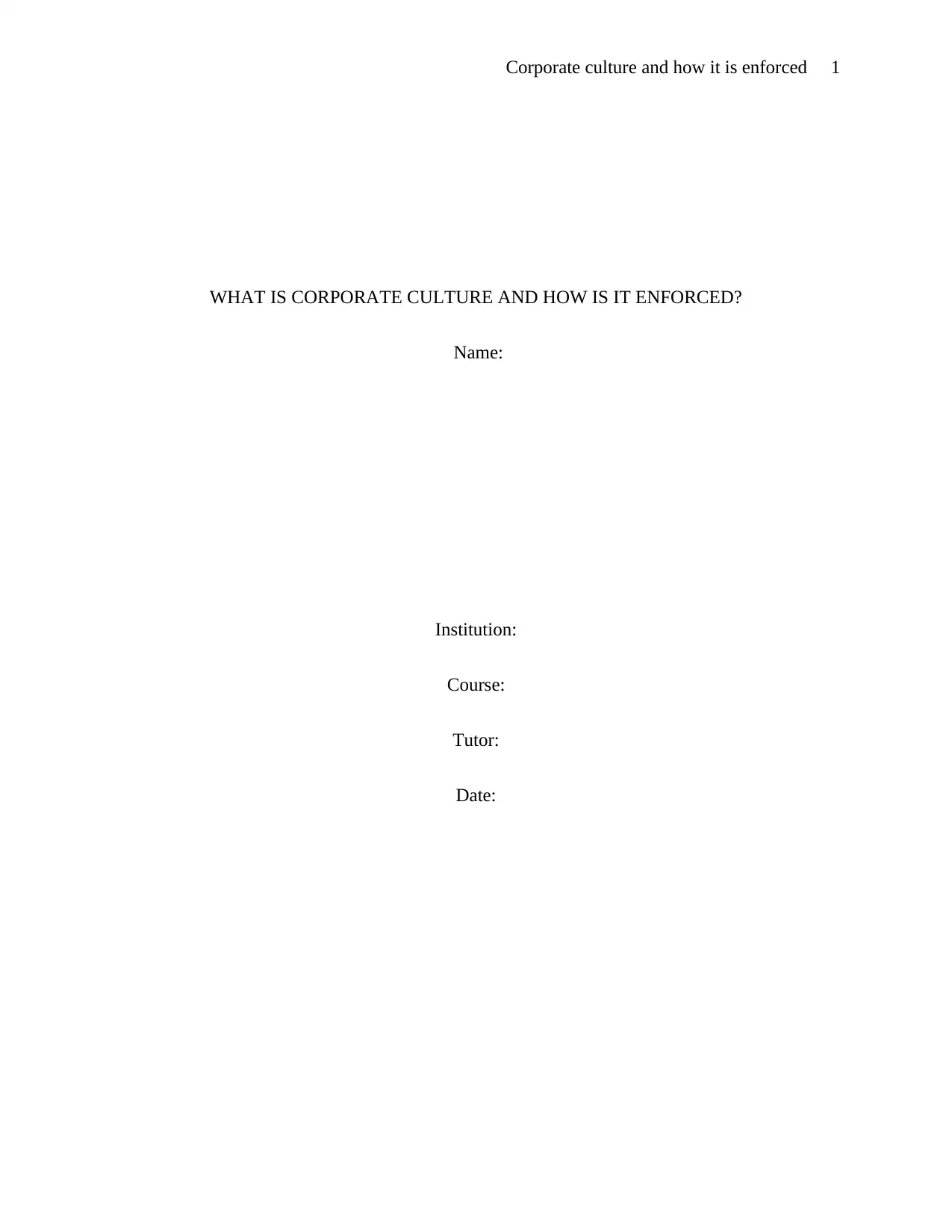
Corporate culture and how it is enforced 1
WHAT IS CORPORATE CULTURE AND HOW IS IT ENFORCED?
Name:
Institution:
Course:
Tutor:
Date:
WHAT IS CORPORATE CULTURE AND HOW IS IT ENFORCED?
Name:
Institution:
Course:
Tutor:
Date:
Paraphrase This Document
Need a fresh take? Get an instant paraphrase of this document with our AI Paraphraser
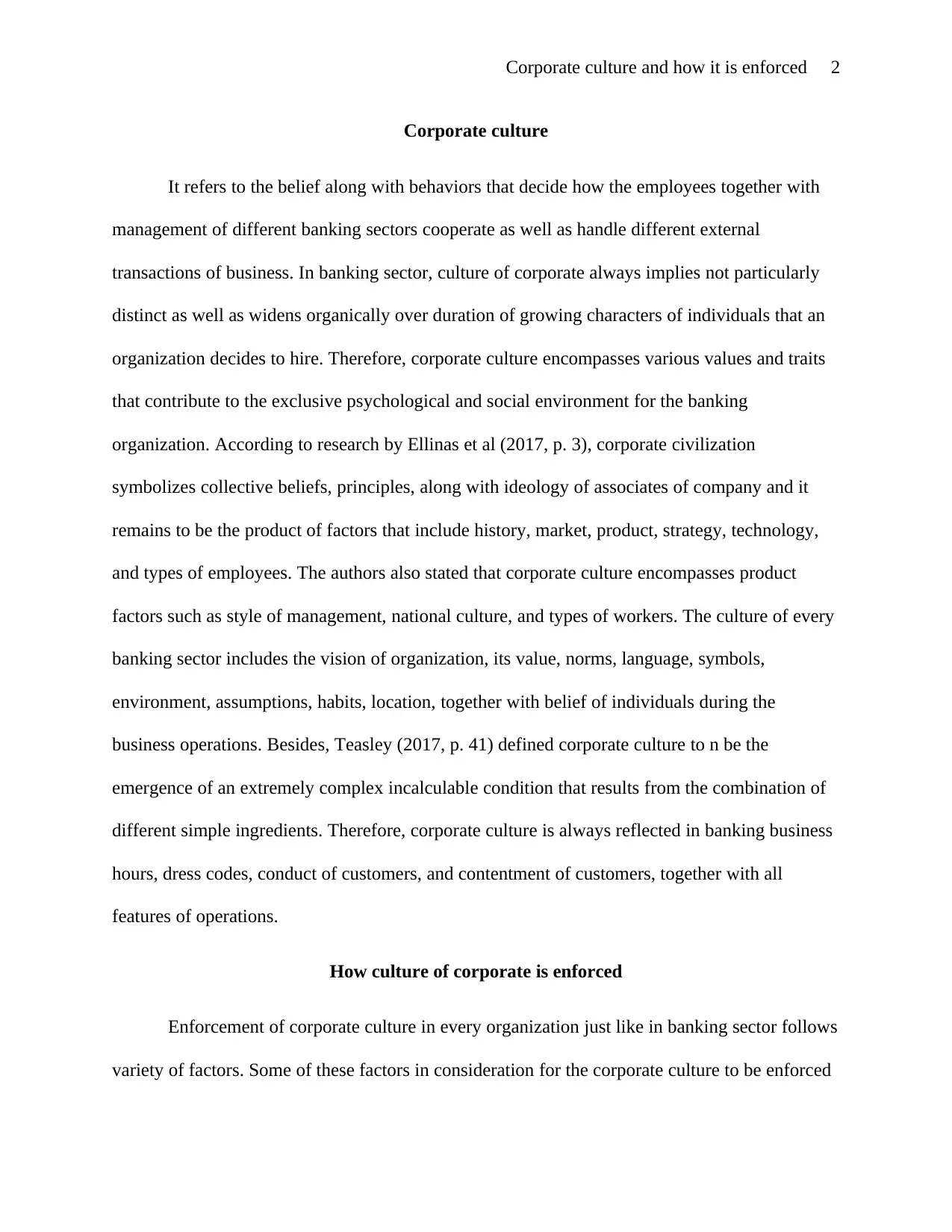
Corporate culture and how it is enforced 2
Corporate culture
It refers to the belief along with behaviors that decide how the employees together with
management of different banking sectors cooperate as well as handle different external
transactions of business. In banking sector, culture of corporate always implies not particularly
distinct as well as widens organically over duration of growing characters of individuals that an
organization decides to hire. Therefore, corporate culture encompasses various values and traits
that contribute to the exclusive psychological and social environment for the banking
organization. According to research by Ellinas et al (2017, p. 3), corporate civilization
symbolizes collective beliefs, principles, along with ideology of associates of company and it
remains to be the product of factors that include history, market, product, strategy, technology,
and types of employees. The authors also stated that corporate culture encompasses product
factors such as style of management, national culture, and types of workers. The culture of every
banking sector includes the vision of organization, its value, norms, language, symbols,
environment, assumptions, habits, location, together with belief of individuals during the
business operations. Besides, Teasley (2017, p. 41) defined corporate culture to n be the
emergence of an extremely complex incalculable condition that results from the combination of
different simple ingredients. Therefore, corporate culture is always reflected in banking business
hours, dress codes, conduct of customers, and contentment of customers, together with all
features of operations.
How culture of corporate is enforced
Enforcement of corporate culture in every organization just like in banking sector follows
variety of factors. Some of these factors in consideration for the corporate culture to be enforced
Corporate culture
It refers to the belief along with behaviors that decide how the employees together with
management of different banking sectors cooperate as well as handle different external
transactions of business. In banking sector, culture of corporate always implies not particularly
distinct as well as widens organically over duration of growing characters of individuals that an
organization decides to hire. Therefore, corporate culture encompasses various values and traits
that contribute to the exclusive psychological and social environment for the banking
organization. According to research by Ellinas et al (2017, p. 3), corporate civilization
symbolizes collective beliefs, principles, along with ideology of associates of company and it
remains to be the product of factors that include history, market, product, strategy, technology,
and types of employees. The authors also stated that corporate culture encompasses product
factors such as style of management, national culture, and types of workers. The culture of every
banking sector includes the vision of organization, its value, norms, language, symbols,
environment, assumptions, habits, location, together with belief of individuals during the
business operations. Besides, Teasley (2017, p. 41) defined corporate culture to n be the
emergence of an extremely complex incalculable condition that results from the combination of
different simple ingredients. Therefore, corporate culture is always reflected in banking business
hours, dress codes, conduct of customers, and contentment of customers, together with all
features of operations.
How culture of corporate is enforced
Enforcement of corporate culture in every organization just like in banking sector follows
variety of factors. Some of these factors in consideration for the corporate culture to be enforced
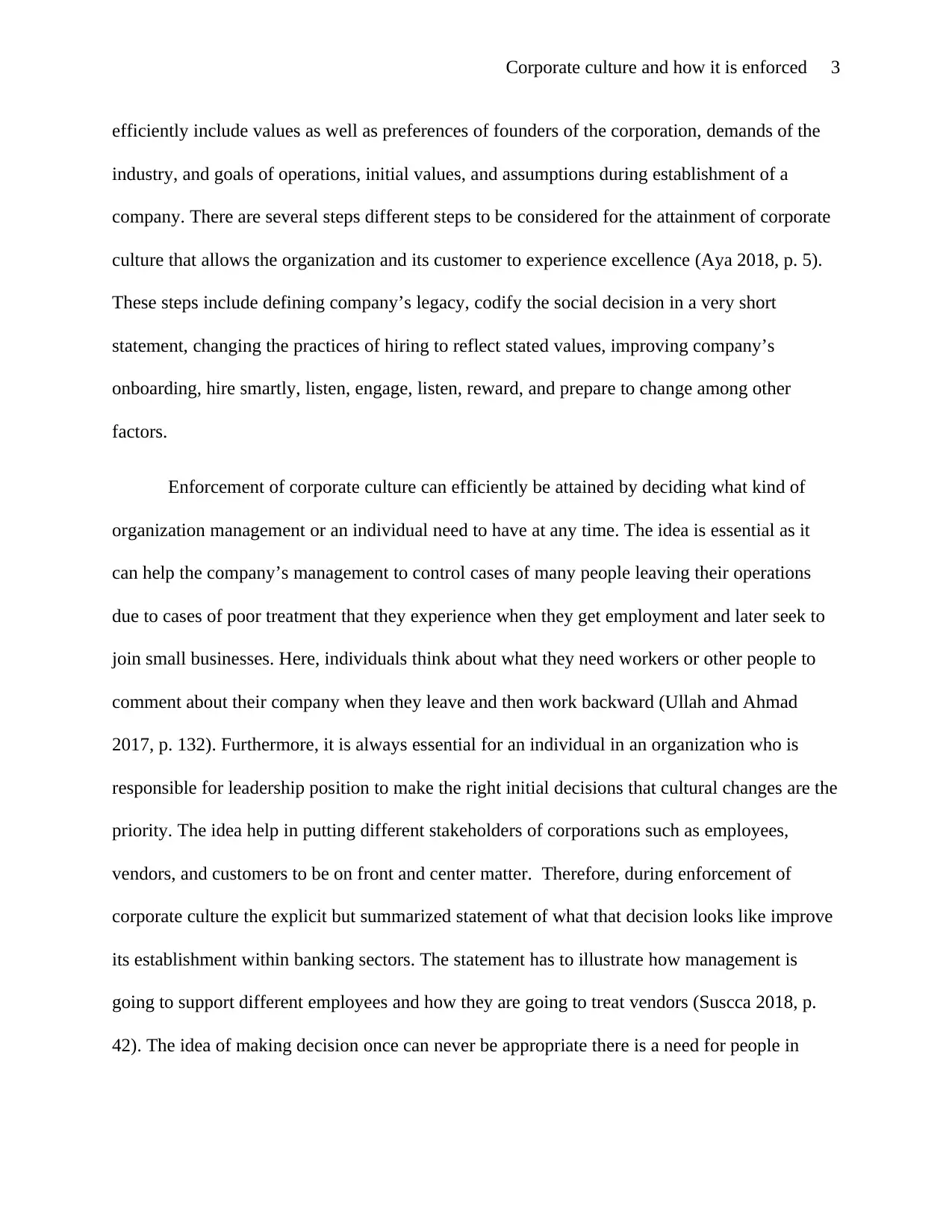
Corporate culture and how it is enforced 3
efficiently include values as well as preferences of founders of the corporation, demands of the
industry, and goals of operations, initial values, and assumptions during establishment of a
company. There are several steps different steps to be considered for the attainment of corporate
culture that allows the organization and its customer to experience excellence (Aya 2018, p. 5).
These steps include defining company’s legacy, codify the social decision in a very short
statement, changing the practices of hiring to reflect stated values, improving company’s
onboarding, hire smartly, listen, engage, listen, reward, and prepare to change among other
factors.
Enforcement of corporate culture can efficiently be attained by deciding what kind of
organization management or an individual need to have at any time. The idea is essential as it
can help the company’s management to control cases of many people leaving their operations
due to cases of poor treatment that they experience when they get employment and later seek to
join small businesses. Here, individuals think about what they need workers or other people to
comment about their company when they leave and then work backward (Ullah and Ahmad
2017, p. 132). Furthermore, it is always essential for an individual in an organization who is
responsible for leadership position to make the right initial decisions that cultural changes are the
priority. The idea help in putting different stakeholders of corporations such as employees,
vendors, and customers to be on front and center matter. Therefore, during enforcement of
corporate culture the explicit but summarized statement of what that decision looks like improve
its establishment within banking sectors. The statement has to illustrate how management is
going to support different employees and how they are going to treat vendors (Suscca 2018, p.
42). The idea of making decision once can never be appropriate there is a need for people in
efficiently include values as well as preferences of founders of the corporation, demands of the
industry, and goals of operations, initial values, and assumptions during establishment of a
company. There are several steps different steps to be considered for the attainment of corporate
culture that allows the organization and its customer to experience excellence (Aya 2018, p. 5).
These steps include defining company’s legacy, codify the social decision in a very short
statement, changing the practices of hiring to reflect stated values, improving company’s
onboarding, hire smartly, listen, engage, listen, reward, and prepare to change among other
factors.
Enforcement of corporate culture can efficiently be attained by deciding what kind of
organization management or an individual need to have at any time. The idea is essential as it
can help the company’s management to control cases of many people leaving their operations
due to cases of poor treatment that they experience when they get employment and later seek to
join small businesses. Here, individuals think about what they need workers or other people to
comment about their company when they leave and then work backward (Ullah and Ahmad
2017, p. 132). Furthermore, it is always essential for an individual in an organization who is
responsible for leadership position to make the right initial decisions that cultural changes are the
priority. The idea help in putting different stakeholders of corporations such as employees,
vendors, and customers to be on front and center matter. Therefore, during enforcement of
corporate culture the explicit but summarized statement of what that decision looks like improve
its establishment within banking sectors. The statement has to illustrate how management is
going to support different employees and how they are going to treat vendors (Suscca 2018, p.
42). The idea of making decision once can never be appropriate there is a need for people in
⊘ This is a preview!⊘
Do you want full access?
Subscribe today to unlock all pages.

Trusted by 1+ million students worldwide
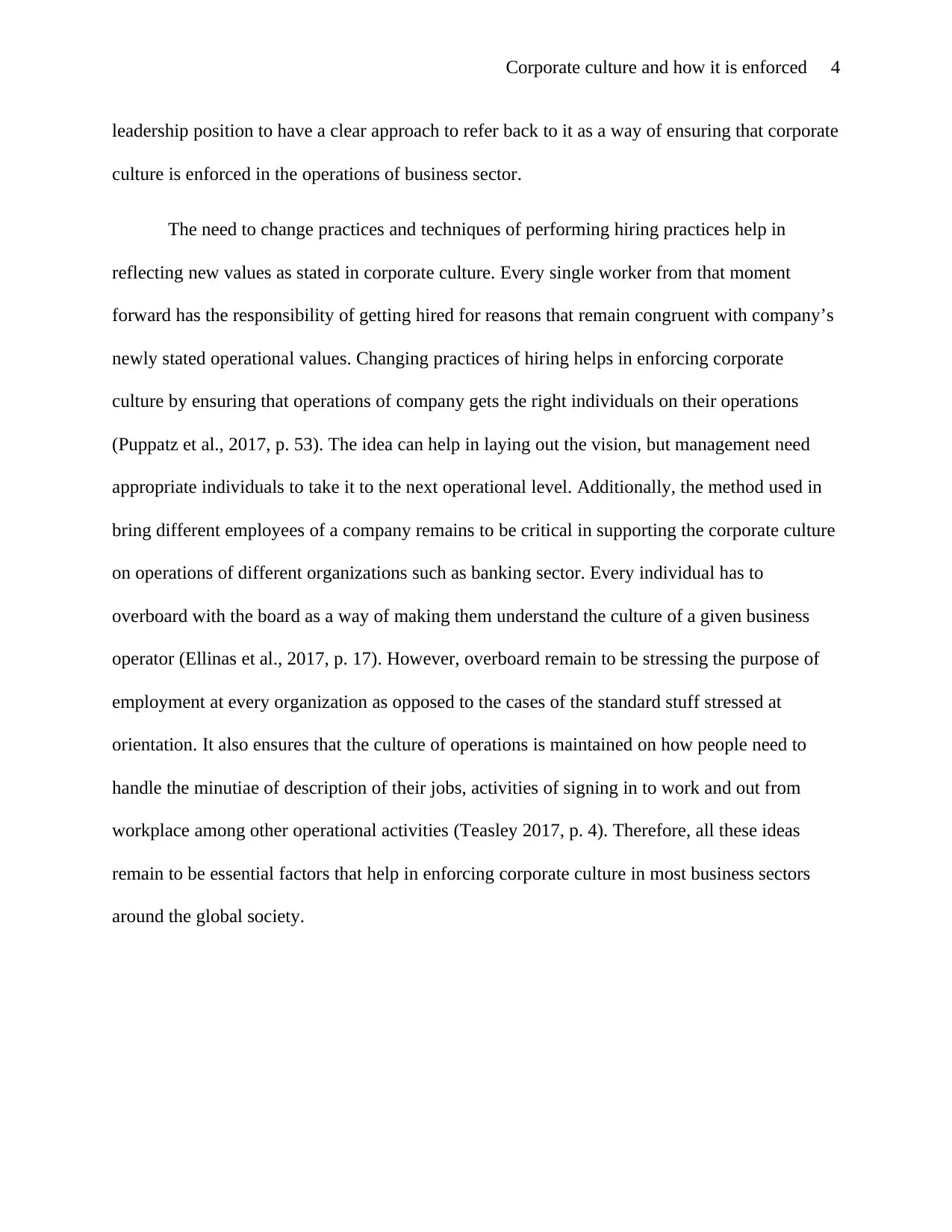
Corporate culture and how it is enforced 4
leadership position to have a clear approach to refer back to it as a way of ensuring that corporate
culture is enforced in the operations of business sector.
The need to change practices and techniques of performing hiring practices help in
reflecting new values as stated in corporate culture. Every single worker from that moment
forward has the responsibility of getting hired for reasons that remain congruent with company’s
newly stated operational values. Changing practices of hiring helps in enforcing corporate
culture by ensuring that operations of company gets the right individuals on their operations
(Puppatz et al., 2017, p. 53). The idea can help in laying out the vision, but management need
appropriate individuals to take it to the next operational level. Additionally, the method used in
bring different employees of a company remains to be critical in supporting the corporate culture
on operations of different organizations such as banking sector. Every individual has to
overboard with the board as a way of making them understand the culture of a given business
operator (Ellinas et al., 2017, p. 17). However, overboard remain to be stressing the purpose of
employment at every organization as opposed to the cases of the standard stuff stressed at
orientation. It also ensures that the culture of operations is maintained on how people need to
handle the minutiae of description of their jobs, activities of signing in to work and out from
workplace among other operational activities (Teasley 2017, p. 4). Therefore, all these ideas
remain to be essential factors that help in enforcing corporate culture in most business sectors
around the global society.
leadership position to have a clear approach to refer back to it as a way of ensuring that corporate
culture is enforced in the operations of business sector.
The need to change practices and techniques of performing hiring practices help in
reflecting new values as stated in corporate culture. Every single worker from that moment
forward has the responsibility of getting hired for reasons that remain congruent with company’s
newly stated operational values. Changing practices of hiring helps in enforcing corporate
culture by ensuring that operations of company gets the right individuals on their operations
(Puppatz et al., 2017, p. 53). The idea can help in laying out the vision, but management need
appropriate individuals to take it to the next operational level. Additionally, the method used in
bring different employees of a company remains to be critical in supporting the corporate culture
on operations of different organizations such as banking sector. Every individual has to
overboard with the board as a way of making them understand the culture of a given business
operator (Ellinas et al., 2017, p. 17). However, overboard remain to be stressing the purpose of
employment at every organization as opposed to the cases of the standard stuff stressed at
orientation. It also ensures that the culture of operations is maintained on how people need to
handle the minutiae of description of their jobs, activities of signing in to work and out from
workplace among other operational activities (Teasley 2017, p. 4). Therefore, all these ideas
remain to be essential factors that help in enforcing corporate culture in most business sectors
around the global society.
Paraphrase This Document
Need a fresh take? Get an instant paraphrase of this document with our AI Paraphraser
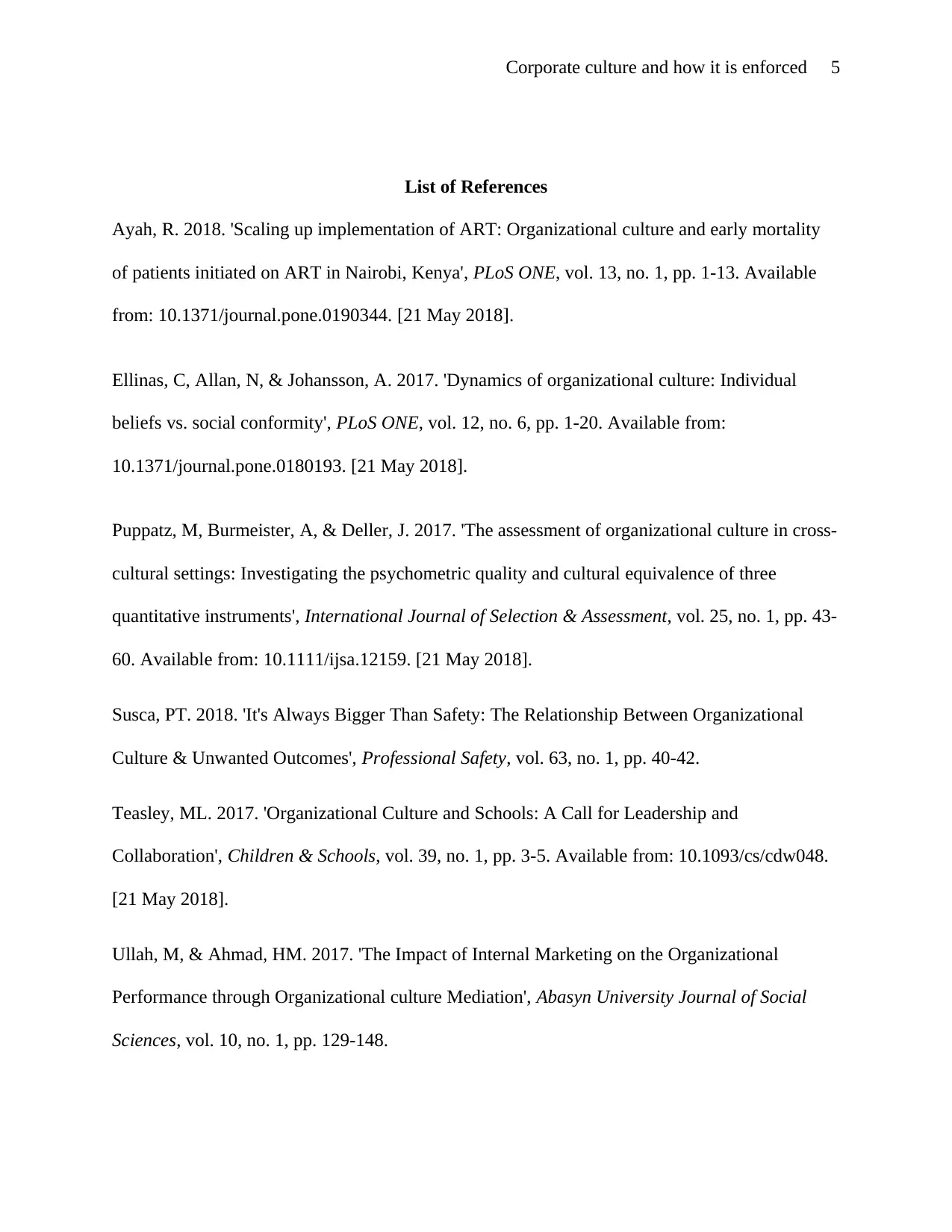
Corporate culture and how it is enforced 5
List of References
Ayah, R. 2018. 'Scaling up implementation of ART: Organizational culture and early mortality
of patients initiated on ART in Nairobi, Kenya', PLoS ONE, vol. 13, no. 1, pp. 1-13. Available
from: 10.1371/journal.pone.0190344. [21 May 2018].
Ellinas, C, Allan, N, & Johansson, A. 2017. 'Dynamics of organizational culture: Individual
beliefs vs. social conformity', PLoS ONE, vol. 12, no. 6, pp. 1-20. Available from:
10.1371/journal.pone.0180193. [21 May 2018].
Puppatz, M, Burmeister, A, & Deller, J. 2017. 'The assessment of organizational culture in cross-
cultural settings: Investigating the psychometric quality and cultural equivalence of three
quantitative instruments', International Journal of Selection & Assessment, vol. 25, no. 1, pp. 43-
60. Available from: 10.1111/ijsa.12159. [21 May 2018].
Susca, PT. 2018. 'It's Always Bigger Than Safety: The Relationship Between Organizational
Culture & Unwanted Outcomes', Professional Safety, vol. 63, no. 1, pp. 40-42.
Teasley, ML. 2017. 'Organizational Culture and Schools: A Call for Leadership and
Collaboration', Children & Schools, vol. 39, no. 1, pp. 3-5. Available from: 10.1093/cs/cdw048.
[21 May 2018].
Ullah, M, & Ahmad, HM. 2017. 'The Impact of Internal Marketing on the Organizational
Performance through Organizational culture Mediation', Abasyn University Journal of Social
Sciences, vol. 10, no. 1, pp. 129-148.
List of References
Ayah, R. 2018. 'Scaling up implementation of ART: Organizational culture and early mortality
of patients initiated on ART in Nairobi, Kenya', PLoS ONE, vol. 13, no. 1, pp. 1-13. Available
from: 10.1371/journal.pone.0190344. [21 May 2018].
Ellinas, C, Allan, N, & Johansson, A. 2017. 'Dynamics of organizational culture: Individual
beliefs vs. social conformity', PLoS ONE, vol. 12, no. 6, pp. 1-20. Available from:
10.1371/journal.pone.0180193. [21 May 2018].
Puppatz, M, Burmeister, A, & Deller, J. 2017. 'The assessment of organizational culture in cross-
cultural settings: Investigating the psychometric quality and cultural equivalence of three
quantitative instruments', International Journal of Selection & Assessment, vol. 25, no. 1, pp. 43-
60. Available from: 10.1111/ijsa.12159. [21 May 2018].
Susca, PT. 2018. 'It's Always Bigger Than Safety: The Relationship Between Organizational
Culture & Unwanted Outcomes', Professional Safety, vol. 63, no. 1, pp. 40-42.
Teasley, ML. 2017. 'Organizational Culture and Schools: A Call for Leadership and
Collaboration', Children & Schools, vol. 39, no. 1, pp. 3-5. Available from: 10.1093/cs/cdw048.
[21 May 2018].
Ullah, M, & Ahmad, HM. 2017. 'The Impact of Internal Marketing on the Organizational
Performance through Organizational culture Mediation', Abasyn University Journal of Social
Sciences, vol. 10, no. 1, pp. 129-148.
1 out of 5
Related Documents
Your All-in-One AI-Powered Toolkit for Academic Success.
+13062052269
info@desklib.com
Available 24*7 on WhatsApp / Email
![[object Object]](/_next/static/media/star-bottom.7253800d.svg)
Unlock your academic potential
Copyright © 2020–2025 A2Z Services. All Rights Reserved. Developed and managed by ZUCOL.





